INTRODUCTION.
India’s westernmost state, created in 1949 formerly known as Rajputana is also one of the most colorful part of India . The area is diagonally divided by the Aravali hills, the area to the northwest is a largely taken up by desert where drought and famine are constant threats.
In spite of sterile land it is frequently described as ‘colorful’ or ‘vibrant’: epithets that spring not from any natural luxuriance but rather from the traditional way of life and, in particular ,the brilliant costumes of Rajasthanies, which enliven the desert landscape and relieve the monotony of the sand, rock and scrubby trees.
In contrast to the predominant white clothing of the lush green areas of the southern and western India, in Rajasthan the glowing red and yellow odanies or turban is valued as an affirmation of life in the face of hardship and deprivation of the most basic kind.
In total the production of Textiles accounts 21.96 % in the state. Out of 862 spinning mills in India, 69 spinning mills are in Rajasthan.
TEXTILES
Rajasthan’s textiles represent an amalgamation of generations of experimentation with fabric, handicraft skills and a sharp eye for detail. These textiles, woven with incredible precision, are the result of an oral tradition that has passed down generations, and been honed with finesse and purpose. It is always advisable to “buy local” – i.e. visit small villages instead of buying from Rajasthan’s urban shopping centers, as this is where you can get the kind of fabric, weaving and embroidery that is impossible to get anywhere else in the world.
Rajasthan had mastered fabric dyeing much before America’s fascination with hippie tie and dye T patterns.
BANDHINI

Tiny, incredibly precise designs are achieved in cloth by plucking and tying a thread to reveal artwork in bright shades of like vermillion, saffron, emerald, sapphire, and yellow yields. Along with style, there is also symbolism here – red can represent a Hindu bride, and yellow signifies maternity. Bandhini use is common on turbans, dupattas, and sarees, in accompaniment with embroidery, mirror-work, and appliqué.
Leheriya’

Named after flowing waves of water, Leheriya work focuses on clear patterns, created on thin cotton or silk cloth, for turbans or saris. Authentic Leheriya fabric is sold with the knots (used for dyeing) still in place.
Bagru

Very much similar to Sanganeri block printing, Bagru’s textile printers chose to focus on floral designs, and exclusively print using vegetable colour. Bagru work is also famed for its zigzag motifs.
Sanganeri

Rajasthan’s most popular hub of block and screen printing is Sanganer, famed for its sheer variety of folk patterns on white cotton. It is great for home linens and furnishing, including bed covers, table cloths etc. These motifs are made with thin black outlines and the use of red dye to colour figures and flowers.
Barmeri Prints

Bold geometric prints are what set Barmer’s prints apart from the rest of Rajasthani textiles. Additionally, unlike the light floral colours, Barmer fabrics show darker shades as it takes inspiration from the Barmer’s location in the Thar Desert, where locals believe dark shades are cooler.
Jaipuri Quilts

Famed across the world for their softness, warmth and the artistic attention to detail, they are worth the high price they command. Not only do they insulate well, but they’re also lightweight. Adornments include frills and embroidery. They are fluffy, and traditionally use 100 % pure, finely combed cotton with a high thread count and double stitching.
Kota Doria

Kota Doria is among the many types of sari textiles made in Rajasthan’s Kota region, where it gets its name from. These pure cotton and silk fabrics feature checkered square patterns, and are famed for their lightweight feel. Historically, Kota Doria weaving came from Mysore, after weavers were brought from Mysore to Kota by a Mughal army general. Application of a mixture of onion juice and rice paste during the process of weaving ensures the finish is incredibly durable. It is common to spot machine-made Kota Doria fabric today.
Block Printing
Block Printing is an ancient craft form of Rajasthan that is being practiced since time immemorial. Natural colors are used in Block Printing. Rajasthan is well known for the art of block printing that is hugely practiced there even till date. The process of doing block printing flourished since the 12th century when the art received a royal patronage from the kings of the era. Block Printing is done on cotton fabrics. Rajasthan is an important center in India where block printing has gained a good prominence and the designs of the block printing that originated in Rajasthan are considered the most popular and best of all other designs.
History:
During the 12th century, the parts of Rajasthan and Gujarat became famous for the art of Block Printing that was hugely practiced. The block printing of Rajasthan in India was exported in a large number from India.
Description:
Block Printing can be distinguished into two categories, The Sanganeri and Bagru prints. Although much difference is not noted, but the background color of the Fabric marks the difference between the two. The Sanganeri prints are done on a white background and the Bagru prints are essentially done on background of red and black. Block Printing of Rajasthan in India is known for the intricate designs and the details that are made on the block prints. Block printing is done on rich and vibrant colors and this aspect has given prominence to Block Printing as a craft of Rajasthan.
The wooden blocks of different shapes and sizes used for block printing are called bunta. The base of the block has the design carved on it. The fabric is washed free of starch before printing is done on it. Printing is done from left to right. Standard colors used for block printing are black, brown, orange, red, and mustard. The fabric is dried out in the sun after the block printing is done.
Blocks and printing styles of Bagru and Saanganer
Block making in Saanganer
According to the 2008 census, 152 block carving units exist in Saanganer. Very special and interesting terminology is used in these units, words that one does not find in everyday language. It seems that the printers have developed their own language, which is important to understand, to be able to work with them. Let us look at some of these words.
A block maker or a carpenter who specializes in block making is called “Bhatt-ghar“- in Rajasthan. Here Bhatt implies block and the ghar implies the carver. The block printers of Saanganer get most of their blocks made in Purani Basti in Jaipur. Those blocks that need some special technical input are usually sent to Farukhabaad, Sitapur, Meerut or Pilakuan in UP or Pethapur in Gujarat.
Motifs of Saanganer
Finesse in flowers-petal designs, curves and delicacy are the prime specialties of Saanganer prints. The curvature of flowers in the ’bootas’ is generally shown on the right side. Different types of floral patterns are displayed in the form of a ‘bel’ (a border), in a stylized manner.
Some of the flowers used in the prints are roses, rosettes, lotuses, lotus bud, sunflower, lily, ‘champa’ ‘canna’ ‘nergis’, marigold etc. Various other flower creations are also found in old Saanganeri prints. Other flowers used are locally known as ‘sosan’, ‘gainda’, ‘gulmehendi’, ‘javakusum’, ‘guldaudi’, ‘kachnar’, ‘jatadari lily’, ‘kaner’, ‘kanna’, ‘gullalla’, ‘Sosan’ and ‘gullala’ prints are probably very suitable to Saanganeri style of printing, therefore they are used in various forms.
In ‘booties’, generally, only one type of flower-petal and bud creations is found; for example: ‘Badaam, (almond)’, ‘Paan’ (beetle leaf), ‘mukut of ‘kalanga’. While printing a sari, if the ‘booti’ is of ‘sosan’ flower then the ‘bel’ will also be of ‘sosan’ flower and a big ’boota’ of the same flower is usually done on the ‘Pallav’ (the decorative edge of the sari, which is displayed by the women, and left hanging from the shoulders ). Hence, for printing one sari, a large number of blocks need to be made. By printing different booties together, the Saanganeri ‘Cheepas’ have portrayed excellent know how. Sometimes more than three flowers are fitted beautifully in a single ‘booti’ e.g. in ‘Latkan booti’ banana tree, sosan tree and saro tree collection in assembled beautifully in one pattern. The designs are named accordingto the flowers or plant pattern, from which the designs were originally inspired.
Many flowers used in Saanganeri prints don’t originate from Rajasthan. On this basis, Historian James watt has said, “Obviously many of the Saanganeri designs portray flowers that in not likely to have been seen by the calico printers nor by the block engravers of Rajputana. In spite of these circumstances, however, there seems every reason to believe that the craft has been handed down for centuries and has come to be used in all the purity of original inspiration. The nature, feeling and colour reciprocity, as also the technique in printing are all perfect while the absence of machine regularity gives a charm that place these goods above and beyond anything as yet accomplished in Europe.” Apart from flowers, fruit trees of banana, dates, grapes pomegranate etc. have also been recreated in a very attractive manner. In some old prints figures of parrots and fish are also seen. Since about fifty years, elephant. Horse, camel, peacock and human figures are also used. These are mostly seen on curtains, bedcovers, table clothes etc.


Motifs of Bagru
The historical progress of the motifs of Bagru is difficult to understand. These are mostly derived from the flora and fauna and are natural in origin. A Comparative study of the evolution and layout of motifs clearly reveal a change from old tradition and style. Initially the prints were primarily floral and vegetative. After the Persian influence they became more geometrical, for example one often finds a central round and then motifs are placed around it. The motifs of Bagru may be classified into five types:
Motifs of flowers and birds: These are often found in the stem or in the central motives which helps to balance the floral arrangement.
Motifs of inter-twisted tendrils: These are motifs of flowers comprising of spiralled or inter-twisted stems, with flowers, leaves or birds present on the same. These are used as ‘bels’.
Motifs of trellis designs: These are mainly the ‘Jaal’ intricate grid (connecting designs), which were formulated under the Persian influence.
Motifs of figurative designs: These are animal, bird and human motifs, e.g., ‘hiran’ (deer), mayur’ (peacock), ‘sua’ (parrot).
Motifs of geometrical designs: These are geometrical in shapes, e.g. ‘Leheriya’ (wave), ‘chaupad’ (check), ‘kanguras’ (triangular), ‘chatais’ (woven) pattern etc.
Motifs of Bagru
The historical progress of the motifs of Bagru is difficult to understand. These are mostly derived from the flora and fauna and are natural in origin. A Comparative study of the evolution and layout of motifs clearly reveal a change from old tradition and style. Initially the prints were primarily floral and vegetative. After the Persian influence they became more geometrical, for example one often finds a central round and then motifs are placed around it. The motifs of Bagru may be classified into five types:
Motifs of flowers and birds: These are often found in the stem or in the central motives which helps to balance the floral arrangement.
Motifs of inter-twisted tendrils: These are motifs of flowers comprising of spiralled or inter-twisted stems, with flowers, leaves or birds present on the same. These are used as ‘bels’.
Motifs of trellis designs: These are mainly the ‘Jaal’ intricate grid (connecting designs), which were formulated under the Persian influence.
Motifs of figurative designs: These are animal, bird and human motifs, e.g., ‘hiran’ (deer), mayur’ (peacock), ‘sua’ (parrot).
Motifs of geometrical designs: These are geometrical in shapes, e.g. ‘Leheriya’ (wave), ‘
chaupad’ (check), ‘kanguras’ (triangular), ‘chatais’ (woven) pattern etc.



Difference between Saanganeri and Bagru style of printing
The main distinguishing feature between Saanganer and Bagru printing is that Saanganer print is usually done on a white ground, whereas Bagru prints are printed on an Indigo or a dyed background. Local water also has its effects. In the water of Saanganer, the results of block printing are very rich dark shades of colour, while at Bagru one finds a reddish tinge in the block printed textiles. Water was (intentionally being used in the past tense) abundant in Saanganer; due to which dyeing, printing as well as washing could be done very easily. In contrast at Bagru, where wateris comparatively scarce, ‘Dhabu’ resist printing and indigo work is practised more often.
Traditionally, motifs printed at Bagru are large with bold lines, as compared to Saanganer, where sombre colours and fine lines, intricate detailing are practiced. Saanganeri motifs are based on nature, while the motifs of Bagru are more often geometric.
Blocks have been used in many ways
Till 50 years back most of the fabrics that were being printed were quite coarse and thick cottons, usually handwoven. The printer often women or older men were sitting on the floor usually outside the house and printing during the day time, when they became free from their house hold work.
They printed on very small low tables called the “Paatiya”.
The blocks used were quite small in size. Once a small portion of the fabric was printed the printer very carefully moved the fabric forward. Due to the thickness of the fabric it was easier to restart printing without any difficulty, exactly where one had stopped.
A point to note here is that if a bigger block would have been used, instead of a tiny block, then the printing would have been done in less than half the time. But the fabric would still be wet with the colour, and thus when it was moved the wet colours would have left spots. Thus it was necessary to use small blocks on the small tables.
In the finer fabrics used today, it is impossible to move the fabric during printing. Thus one must use bigger tables where there is no need to move the fabric during the printing process. In present times, the fabric is fixed with oil pins, on to the table and the printer moves with a trolley having colours and other tools.
In some villages in Kutch when printers print with wax using blocks, they still print on the Paatiya. The wax is very hot when it is printed. The printer keeps dipping his block in the hot boiling wax, close to him, and keeps printing. They often use bigger blocks in this case, as the main product being printed is bedspreads which have a big central medallion. Thus the portion of fabric on the table gets printed quite quickly, but at the same time it dries very quickly as well. What is interesting here is that the table is covered with sand before being covered with the fabric to be printed. The sand being cold dries the wax immediately.
Thus, much technical knowledge is required along with experience, when deciding the kind and size of blocks that can be used in a particular situation. It is not only the low table there is more science to deciding the size of the blocks. There are many factors that one needs to consider, like the printing style, the fabric and so on.
Among the technical differences what seems interesting is the Thassa. Saanganer printers with their history of 450 years of block printing often used these kinds of blocks. The blocks generally were carved out of soft but strong wood called Gurjan, Instead of the block being carved completely, the fine portions were actually created by forcing a piece of metal inside them, which was carved in the shape of the very pattern that needed to be created in the empty space. This formulation of blocks was called “Thassa” (which means pressed). These blocks generally had booti, boota, jaal, pharcha (borders) motifs which were not more than 6”x 6” in size. There were blocks which were 1”x 2” in size too. Saanganer prints were generally for the royalties of Jaipur.11
The same approach towards blocks can be traced back in Germany, in the famous “Blaudruck” technique. Which is basically blue (indigo) printing using resist, there are still a few printers left across Germany who practise the same technique. Initially blocks were made in the same way as a wood cut would be engraved. It was probably around the beginning of the 18th century, that the need for perfection increased considerably. As a result, the blocks were perforated by brass pins and strips driven into them. These strips were shaped as leaves or petals of flowers which were too fine to be cut. Sometimes they were also used to create geometric designs also. Thus a block is not just a carved piece of wood, it can have many additions or subtractions made by the intelligent block makers and printers according to their immediate requirements.

Features of blocks
It may be surprising to learn that wooden blocks can have so many characters. But an art that has evolved over centuries it does have many minutiae. “Pavansaar” is an innovation introduced to facilitate printing. These are basically holes created in the blocks so that air “pavan” can pass through and the block does not get blocked. These blocks also had holes drilled along and across the grains of wood to stop colour from getting trapped in the fine carved area because of capillary action and help in the maintaining the block as well the design that’s printed. This means that due to the presence of holes colour does not spread on the fabric while printing. The holes also reduce the weight of the block.
For Abhrak printing, the blocks have a cylindrical hollow made entirely of copper. Rogan paste is filled inside these hollow cylinders. The design is made in the hollow metal cylindrical block and then transferred on to the fabric with the help of a wooden mallet. The wooden mallet is the same shape as the hollow cylinder. Gold, silver or copper dust is than spread onto the wet paste, extra dust is brushed off after a while. Outside India this technique was used to copy gold embroidered or woven Damask fabrics. A velvet effect was similarly used by printing some kind of gum and then spreading fine woollen powder on the sam
Rajasthan costumes
Rajasthan Costumes are very attractive to compare with other traditional dresses. The Indian State of Rajasthan is the unity of colourful festivals, costumes and folk songs and dances. The Rajasthani traditional costumes are very colourful and quite different to the other traditional costumes of rest of the states. The weather conditions of the state bring to wear the myriad colours. The women folk wear more colourful clothes.
Rajasthan Costumes for Men:
Dhoti is the main Rajasthan traditional dress to the men in Rajasthan. They are called bandia-angarkha and potia. Bandia-angarkha is the traditional dress in the model of a jacket which closely fits the chest and seems loose around the waist. The sleeves to this jacket are very narrow and are longer than the arms. They adjusted at the wrists. Along with this dress men also wear a bright coloured turban or the headdress. The turbans seem in various colours which are fit to the different region’s weather. They wear the turbans according to the region’s weather conditions.



Rajasthan Costumes for Women:
Women of Rajasthan wear mainly Ghaghara, Choli and Odhani dresses. These costumes are in bright colours, especially Ghaghara dresses are in many designs. The dresses are the ankle length long skirt with the narrow waist, which looks like an umbrella at the base. Rajasthani Women prefer to wear the cotton Ghaghara dresses, which are suitable to the weather conditions of Rajasthan. The cotton Ghaghara also very popular and those printed or dyed like mothras and leharlya print.

The odhni, or chunar, is a long piece of cloth, approximately 2.5 meters in length and 1.5 meters in width, and is worn as a veil. Made of light printed or patched fabric, it features beautiful embroidery, beadwork or other embellishments. There are different ways of wearing it, but the most traditional way is tucking one corner inside the ghagra, resting the middle portion on the chest and draping the end part over each shoulder and above the head, covering it gracefully
Women’s traditional accessories
Elaborate necklaces, like Jadau sets, aad (chokers) and Raani Har (long necklaces to the belly button) are worn around the neck, especially by women from affluent families.

The women of tribal groups such as Bhil, Meena or Garasia prefer wearing brass, silver or white metal ornaments. Kaanbali or surliya (earrings), nathani (nosepins), bajubandh (armlets), rakhdi or borla (maang tikkas), tagdi or kardhani (belly or waist chains), payal (anklets), bangadi (bangles), bichuwa (toe rings) and finger rings are also worn to complete the ensemble.

EMBROIDERY TECHNIQUES OF RAJASTHAN
Embroidery in India includes dozens of regional embroidery styles that vary by region on the varied Indian clothing styles. Designs in Indian embroidery are formed on the basis of the texture and the design of the fabric and the stitch. Rajasthan, as its name signifies, was a conglomeration of princely states. They were of all shapes and sizes, wielding varying degrees of power and enjoying wealth and prestige according to their size and martial prowess. Whatever their wealth or size, however, one characteristic was shared by all. The rulers were invariably patrons of the arts.
The traditional Rajasthani Embroidery work was done on cotton, silk or velvet with a variety of fine stitches. The embroidery designs were floral, geometrical or mythological and, showed The common people of Rajasthan beautified their clothes and articles of everyday use with rajasthani embroidery that used simple embroidery stitches and motifs derived from nature and objects familiar to them in their day to day living. The tradition has continued. In Bikaner district or Rajasthan, women embroider their garments by counting threads and building up the pattern by following the warp and weft thus producing geometrical patterns. By using a double running stitch the pattern appears the same on both sides making the garment reversible. The work resembles the great Rajasthan favourite, the bandhani or the tie and dye method of decorating fabric with colour.

hain stitch, done in contrasting colors, is used in Alwar to produce an effect of richness and beauty. Geometrical forms are used with flowing circular lines to produce a sense of movement in the design. Stark contrast is created by producing black and white motifs on a golden yellow background.
In Sikar and Jhunjhunu district of Rajasthan, skirt borders are embroidered with a variety of birds, animals, trees, and flowers. There is a pleasing quality of naiveté in the work. The Rajasthani emrboidery stitches used are simple— herringbone for filling and stem stitch for outlining but a three-dimensional effect is created by using a thick thread in a variety of colors.
The ralli is a patchwork spread made in Jaiselmer district of Rajasthan. Small pieces of material are stitched together in a decorative pattern to form the top of the spread. As in other parts of the country, the padding is made up of layers of old material held together with running stitches. Jaiselmer and Jodhpur also excel in silk thread embroidery on leather which is done especially on shoes and waistcoats. The knuckle pad is another article made of leather which is decorated with scenes resembling miniature paintings. The work done in the cities is fine and in subdued colour and is sometimes highlighted with gold or silver thread. In rural areas the designs are bolder and made with bright colors and thicker thread. Horse and camel saddles are embroidered with an awl and are richly colourful.

. A whole expanse of material is covered with people, projecting arms at awkward angles. Elephants have large staring eyes, short legs and long trunk falling from a small head. Trees are shaped like candelabra with stems sticking out on either side and tapering to a point at the top. A horse stands on stick-thin legs; two sausage-like dogs with curling tails growl at each other while pencil slim human beings carry on various activities.
Rajputi Poshak a Famous Attire of Women’s in Rajasthan
Women’s in Rajasthan almost 80% wear the traditional type of clothes which is known as “Rajputi poshak and Rajasthani dresses other than sarees or salwaar suits. This traditional garment of Rajasthan is sub divided into two groups women’s of Rajput or Rajpurohit Families wear Rajputi poshaks and other women’s wear Rajasthani dress consist of Odhni, Blouse and Ghagras whereas Rajputi Poshaks Consists of Odhni, Kurti, Kanchali, and Ghagras. This Rajputi poshak cover the whole body of women’s that is why it is considered as Royal Dress of Rajasthan as many queens and Princess wear Rajputi Poshak.
The symbol of Royalty and Traditional culture. Gives complete look and grace to women’s who wear this garments. As Rajput females belong to good protocol and well-defined family mainly they follow parda system also known as Ghungat. Rajputi poshaks comes with varied designs and color and embroidery work. Available in casual and weddings wear which is called “Bari”.

Classification of Rajputi Poshaks
Ghagra – A long skirt which touches the feet. Cut in short “kalis” to add width and grandeur at the bottom, more the “kalis” more the grandeur of Ghagra. Tailored with different fabrics in varieties of color, designs and prints.
Kurti and Kanchali – cover the upper body of women’s have two different pieces, kurti is worn over the kanchali. Tailored according to the measure of the body needs expert skills to tailor kanchali and kurti.
Odhani – A long piece of 2.5-meter transparent cloth, made with mild fabric usually georgette, chiffon and tor etc. Having light feather weight. Odhni gives complete look to women. The wearing style of odhani is different is different communities. Cover the whole body with the head add dignity and grace to women. Embellish look can be given by adding patches, embroidery, and some light Zari work.
Rajasthan Arts and Crafts
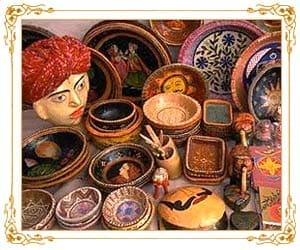
Rajasthan is well known all over the world for its
hand-printed textiles, furniture, leatherwork, jewellery, painting, pottery and
metal craft. The use of lively colors and flamboyant, fantasy designs is
distinctive in all forms of arts and crafts of Rajasthan.It will be unfair to
say that Rajasthani artists only make decorative items. Every household item in
Rajasthan proves the statement false as we go through their embellished
utensils, colorful attires, unique jewellery designs and embroidered shoes that
infuse a new life and a cheerful look to the otherwise monotone of the desert
sands.

Carpets and Dhurries:

Floor coverings like carpets, hand-woven durries and namdas or soft woollen druggets of Rajasthan are exported all over the world. Available in all sizes, the dhurrie is woven in Jaipur and also in the rural areas of the state. Bikaner and Jaisalmer are known for woolen dhurries made of camel hair. Bikaner is also famous for its so-called jail carpets, which are so called for they were once made by the prisoners in the medieval times. Much like Persian carpets, Rajasthani hand-knotted carpets have geometric motifs and formal designs with a border and central motif. The motifs have indeed been localized and include peacocks and other local icons. Jaipur and Bikaner are believed to be the pioneer centres in carpet weaving.
Antiques:
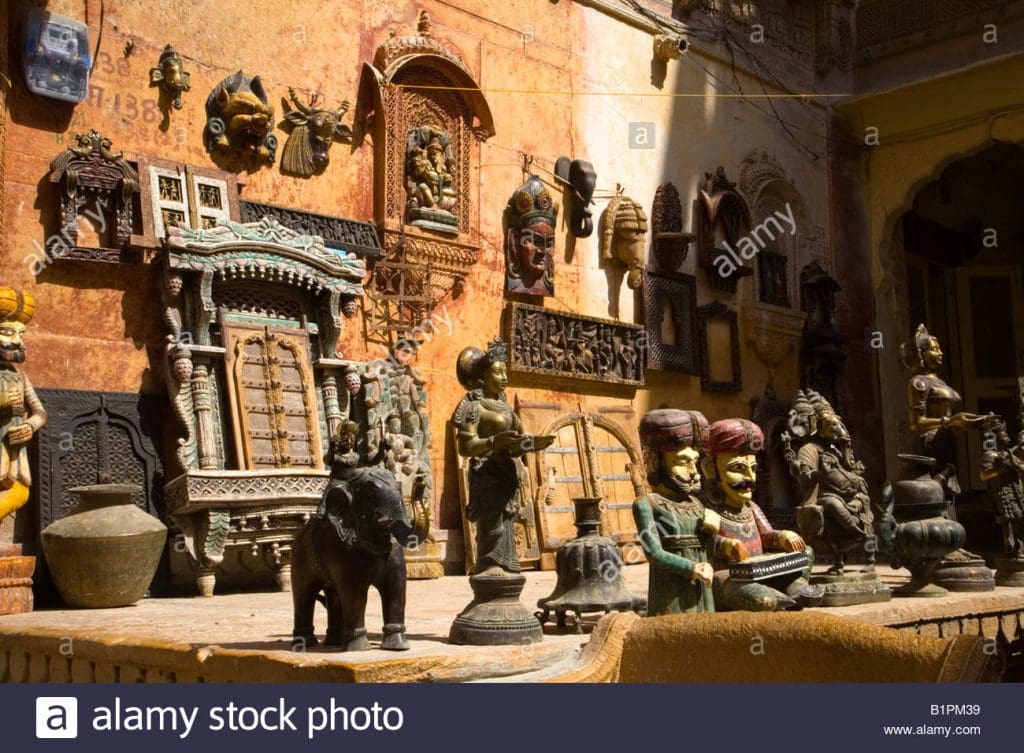
Not all of the items in the handicrafts shop that you find in Rajasthan can exactly pass off as antiques of course but still their distinctive color and designs make them popular among the tourists who buy them as souvenirs and as decorative items for their homes. The large iron oil jars painted in the pichwai style, depicting the love scenes, are just an example. Similarly, variety of kitchen utensils, votive objects and even camel saddles attract attention of the visitors.
Fabrics: Printed, dyed or embroidered fabrics of Rajasthan are known for their unique hues and tones of color. Block printing, batik, tie and dye has become a full-fledged artwork here. Each region has its own distinct motifs, choice of colors, and the way in which these colors are used. Bagru is known for earth colors and geometric patterns while Sanganeri clothes have bright colors and floral patterns. Barmer and Jaisalmer are famous for their batik or reverse printing work. Sikar and Jodhpur are famous for intricate tie-and-dye or bandhani designs including chunari (dotted), lahariya (diagonal striped waves) and mothra (large dots) prints. Bikaner, Sikar and Jhunjhunu are well known for the mirror work, embroidery and appliqué work that are used to embellish these fabrics to produce elaborate designs of Rajasthani dresses.
Furniture and wood carving:
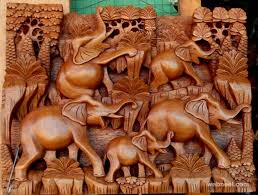
Rajasthan is an ideal place to look for old-worldly doors and windows, wooden jharokhas, tables with cast iron jaalis, side-boards, chairs, benches, jhoolas or swings and dressers, sometimes fretted with brass and copper sheets for decoration. They can be lightly carved or embellished with tiles. Jaipur and Ramgarh in Shekhawati are popular centers for furniture but Jodhpur gets the first place. The notable places are Shekhawati and Bikaner for traditional woodwork, Jodhpur and Kishangarh for painted wooden furniture, Shekhawati, Bikaner and Ramgarh for delicately carved wooden doors, Barmer for woodcarvings such as images of gods and goddesses, elephants, parrots, human and animal figures, Tilonia for leather-embroidered chairs of Tilonia and Shekhawati for carved-back, string-bottom chairs. The most remarkable and finest type of artwork belongs to Bikaner. Known as Gesso work, it is made using the inner hide of the camel, which is scraped till it is paper-thin and translucent and is then molded into various forms of lampshades, hip flasks, perfume phials or vases.
Pottery:

The different regions of Rajasthan have distinctive style of pottery. Jaipur is famous for its blue glazed pottery that doesn’t use simple clay but ground quartz stone, fuller’s earth and sodium sulphate.Terra-cotta pottery is also quite popular in Rajasthan. Molela, a village near Udaipur is specialized in making clay images of deities for ceremonial occasions. Alwar is known for its paper-thin pottery while Bikaner’s painted pottery is tinted with lac colors. The white and red clay articles of Pokaran are marked with distinct geometric designs.
Leather ware:
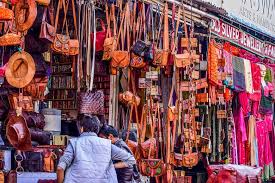
In Rajasthan, jootis (the embroidered footwear the people wear), saddles, bags and pouches are not the only objects made out of animal skins. The other uses to which they are commonly put are making backs of chairs embroidered with woolen motifs. The leather is beaten, tanned and dyed and patterns are made on it by punching and gouging it. Later it is studded and sequined for effect, and embroidered and stitched to create the special jootis (slip-on shoes) that have become a style-statement. Jaipur and Jodhpur are famous for these ‘jootis’.
Metal Crafts:
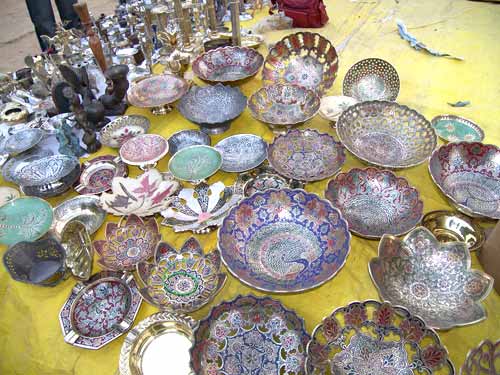
Started off with embellishing the royal armor, the metal crafts of Rajasthan now adorn tabletops, wall plates, flasks, silver animal figures, caparisoned elephants with human figures over a howdah (a musical instrument). Jaipur, Alwar and Jodhpur are famous for their metal wares such as brassware and enameled, engraved and filigree cutwork on silver.
Paintings:

Miniature paintings, portraits, courtly paintings, murals, paintings on cloth and furniture, henna body art, domestic paintings and mandana (the art of decorating houses) are just of the various form of vibrantly colored and intricate Rajasthani paintings.Mostly the paintings depict scenes from Ramayana, Krishna Lila and the Gita Govindam and use rich colors that were made using minerals, vegetables, precious stones, conch shells and metals like gold and silver. Jaipur, Jodhpur, Nathdwara and Kishangarh are important centers of such paintings. Other remarkable styles are phads or scrolls with the tales of the folk-hero Pabuji and the pichwais of Nathdwara near Udaipur, that depict scenes from the with life of Lord Krishna and are often decorated with precious stones.
Puppets:

Painted wooden heads, hands made simply by stuffing rags or cotton into the sleeve of the dress, with painted expressions, arched eyebrows, mustache for men and nose ring for women and large expressive eyes on their face, puppets are draped with dresses made from sequined old fabrics. They are extremely popular as inexpensive mementos among the tourists.
Stone Carving:

The forts and palaces and beautiful havelis of Rajasthan are all superb examples of the exquisite mason work of the state. Dholpur near Bharatpur and Barmer are popular for panels of frescoes for buildings, large statuaries, planters, and intricately carved elephants and horses as garden sculptures. White marble statues of deities are considered to be a specialty of Jaipur.
- Origin of Tribes of Rajasthan
- In Hindu mythology well known Bhil figure is Shabari who offered Lord Rama and Lakshmana half-eaten berries. In Mahabharata there is also the existence of Bhils. The name of the Meenas derived from the Sanskrit word `meen` meaning fish. Meenas are considered to be the descents of Lord Vishnu`s Matsya Avatar.The early history of the tribes of Rajasthan depicts that during the invasions by Hunas, Aryans, Sakas and Kusanas the tribal communities survived the attacks and maintained their cultural and traditional heritage. In order to maintain their livelihood, these tribes of Rajasthan carry on cultivation, while there are quite a number of tribes of Rajasthan state who have developed acumen for business and commercial activities.
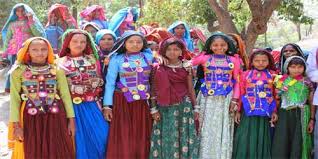
- Religion of Tribes of Rajasthan
- Just like any other tribal community, the tribes of Rajasthan have adapted to religion and also spiritualism. Maximum of theses tribes of Rajasthan are the ardent followers of Hinduism. Sikhism also is quite prevalent amongst these tribes of Rajasthan. Today under the influence of modern day society, these tribes of Rajasthan also take up religions like Buddhism, Islam, Christianity, Parsi religion.
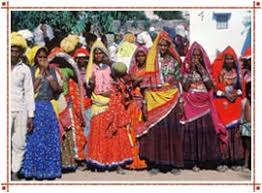
- Costumes of Tribes of Rajasthan
- Both, the males and female members of the tribal communities of Rajasthan dress up in the traditional dresses wholly influenced by several factors like climate, economy, status and the profession, that they are occupied. Festivals, fairs, dancing, music are integral part of these tribes of Rajasthan state.

- Several Tribes of Rajasthan
- Among
the scheduled tribes of Rajasthan, Bhil tribe occupies the major position.
Another scheduled tribe of this state which has got importance is Gadia
Lohar Tribe. At the core of the state of Rajasthan, the Garasia tribes
live with its treasure of cultural tradition as depicted in its superb
language, food habits and gorgeous clothes. Some other tribal communities
or `adivasis` that are found in different parts of Rajasthan are BishnoiTribe, Meena tribes, Meghval and Rabari Tribe.
However, all the tribes of Rajasthan share some common behaviour, the differences being in their jewellery, costumes, fairs and festivals.
- Officialwebsite of Rajsthan tourismhttps://www.tourism.rajasthan.gov.in/

This article was written by Bhavika Gulrajani B.Sc in Textile and Apparel Design from Sir Vithaldas Thackersey College Of Home Science. Textile Value Chain intern.

